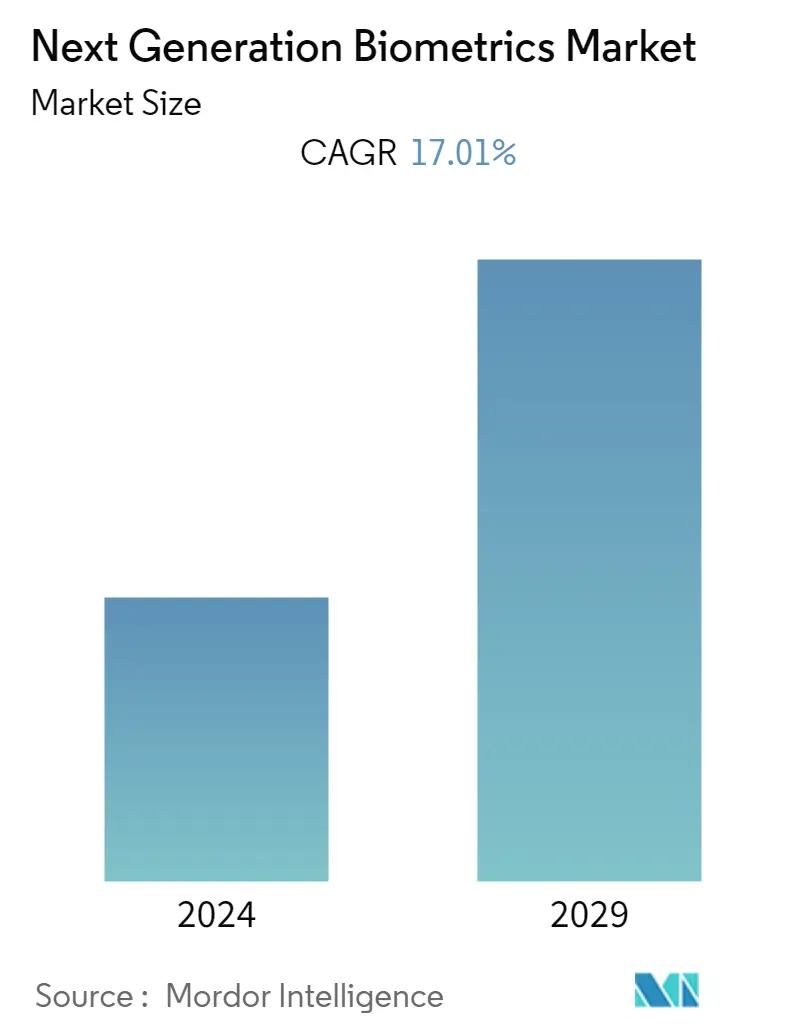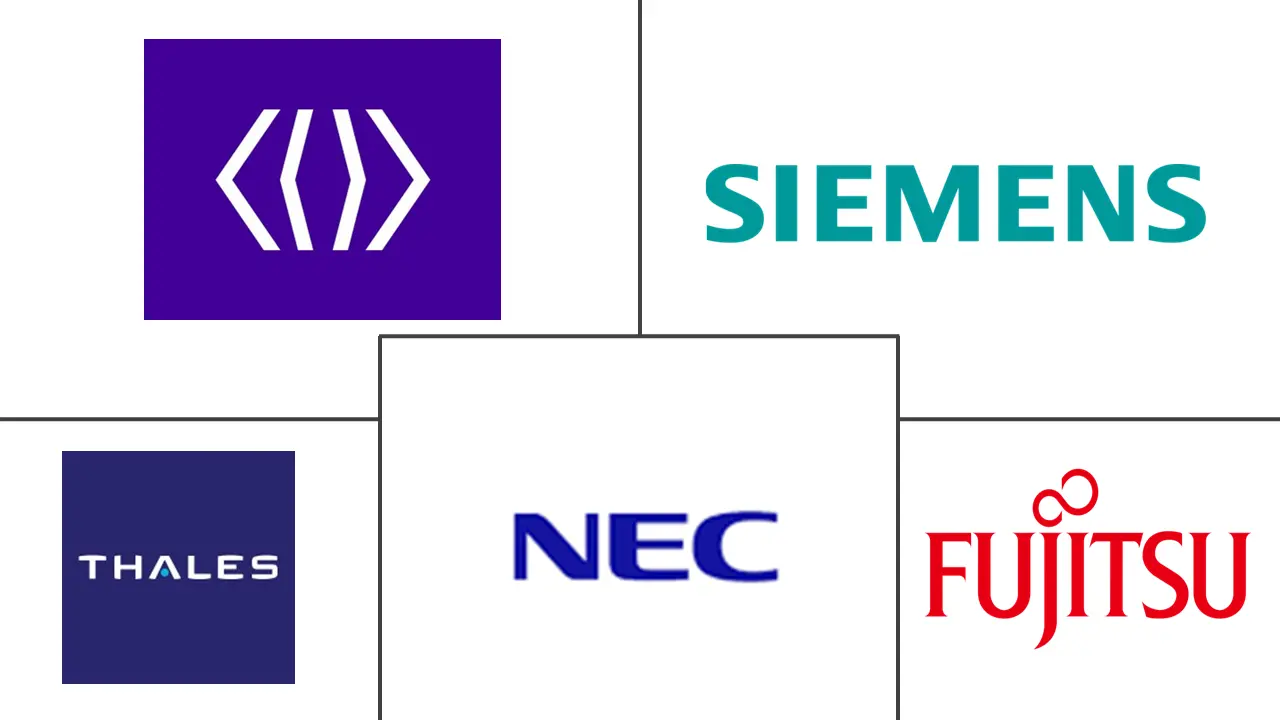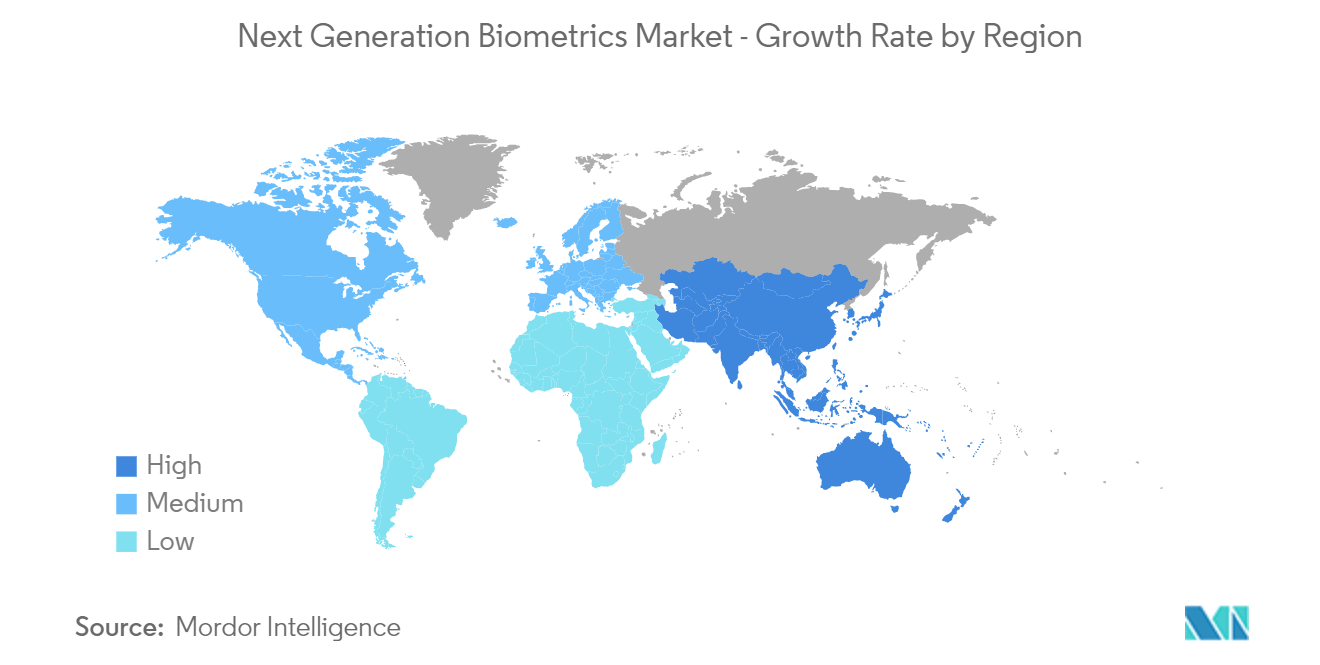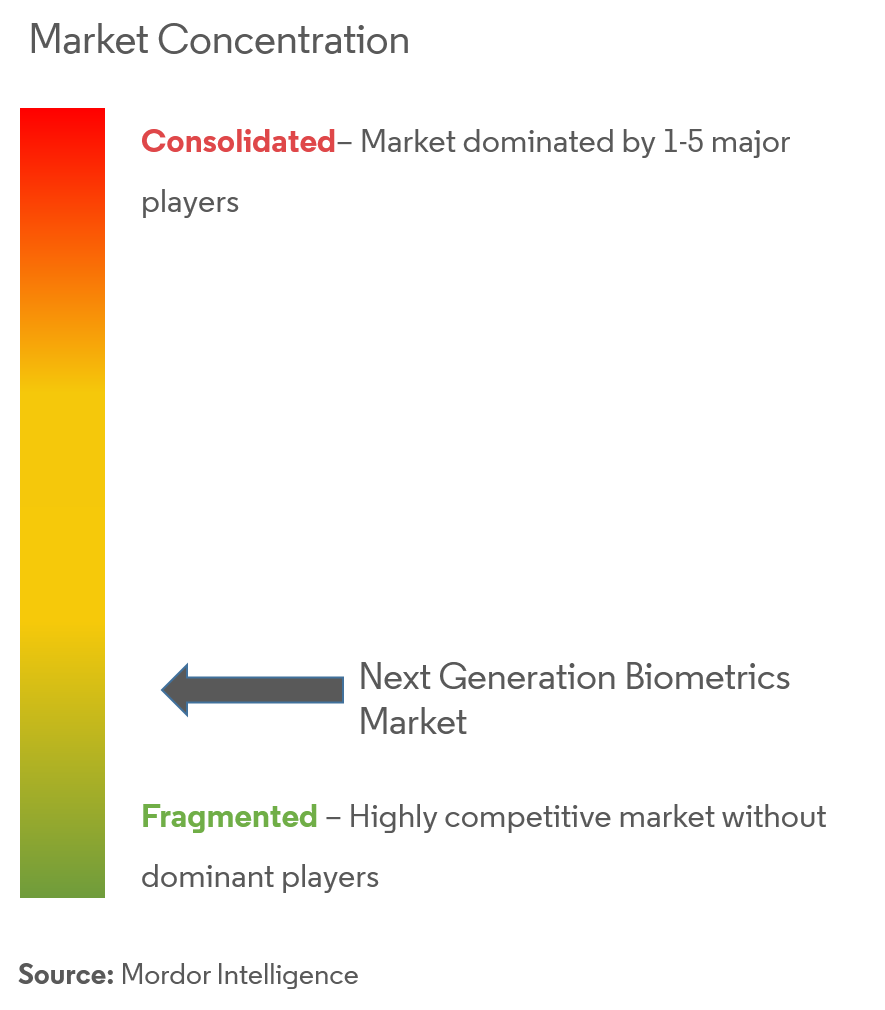Next Generation Biometric Market Size

| Study Period | 2019 - 2029 |
| Base Year For Estimation | 2023 |
| CAGR | 17.01 % |
| Fastest Growing Market | Asia Pacific |
| Largest Market | North America |
| Market Concentration | High |
Major Players
*Disclaimer: Major Players sorted in no particular order |
Next Generation Biometric Market Analysis
The Next Generation Biometrics Market size is expected to grow from USD 42.96 billion in 2023 to USD 94.23 billion by 2028, at a CAGR of 17.01% during the forecast period (2023-2028).
One of the key trends witnessed in the next-generation biometrics market is a paradigm shift in business discourse toward more privacy and fewer security threats. The end-users are increasingly looking for integrated solutions rather than depending on conventional methods.
- The next-generation biometric market is anticipated to grow at a significant growth rate due to the rising number of terrorist activities, coupled with the increasing theft activities on the part of crucial data and information that have raised concerns regarding national security. For instance, in August 2022, Chile is implementing an automatic biometric identification system (ABIS) to combat organized crime. By comparing the biometric records of the civil police (PDI), the civil registry, and Interpol, the system would instantaneously identify recognized criminals, illegal migrants, and the deceased who lack any identity.
- The rising identity fraud across the globe is restricting market growth globally. According to Onfido, Identity fraud rose 43% YoY, with sophisticated fraud increasing 57% as criminals employed smarter tactics, utilizing realistic 2D/3D masks and deploying display attacks (for instance, showing a picture of a person on a screen) to try to spoof verification systems. And with 9 out of 10 consumers comfortable accessing digital services, the opportunities for fraudsters are further increasing.
- The next-generation biometric industry benefits from the increase in electronic cards and biometric passports. Costa Rica, for example, in September 2021, is slated to launch its biometric passport in 2022. The new passport was created using the most advanced security technology to reject fraudulent attempts. It also complies with the demands the International Civil Aviation Organization sets forth. Throughout the projected term, these advances may generate growth opportunities for market development.
- The COVID-19 outbreak significantly increased demand for touchless biometrics solutions, particularly in the healthcare sector, and created substantial disturbances and adjustments in various industries. Advanced multifactor and multimodal biometrics solutions are becoming increasingly important due to their accuracy and conformance with COVID-19's social separation norms.
- Companies must refrain from using fingerprint, palm print, and hand-key scanners to minimize physical touch and virus transmission. These actions are laying the groundwork for facial identification equipment and user-friendly iris scanning, which will be applied in several contexts. The outbreak brought about a trend toward contactless biometric technologies that assess face, gait, and speech recognition for accurate identification, which benefitted the market growth and is expected to grow over the forecast period.
Next Generation Biometric Market Trends
Banking and Financial Industry to be the Fastest Growing Sector
- Central Banks are rolling out biometric authentication. Bank of America, JP Morgan Chase, and Wells Fargo allow customers to log in to mobile banking via fingerprint authentication. Voice authentication is also deployed in bank call centres to identify customers. Next-generation biometric authentication can improve customer satisfaction by eliminating the need for passwords and increasing the demand for biometrics in the banking sector.
- A Visa poll from May 2022 found that 86% of users are eager to utilize biometrics to verify their identification while making payments. 70% of respondents who used biometrics said it was simpler to use them, and 46% said they were safer than credentials or PINs. Thus, increasing the adoption of biometric security for internet banking and mobile payments is expected to contribute to the market growth due to increasing banking fraud.
- According to IDEMIA, in July 2021, a pioneer in biometric solutions worldwide, the Indian banking industry is now more eager to implement safe and practical biometric technologies in the post-Covid era. IDEMIA is seeking to provide various cutting-edge biometric protection and transaction solutions. These developments in the BFSI sector are expected to propel next generation biometrics market over the coming years.
- Internet finance and digital operations have become increasingly popular over the past few years due to the increased use of digital technology in the BFSI sector. Many banks now use biometric facial recognition to access accounts through ATMs, eliminating the requirement to punch a card. For instance, in May 2022, Mastercard introduced a biometric payment method for physical establishments that relies on face recognition biometrics instead than smartphones, smart cards, or memorized PINs.

Asia-Pacific to Witness a Significant Growth Rate over the Forecast Period
- The market in the region is expected to witness significant growth in emerging economies, estimated to grow steadily over the forecast period. Apart from the consumer electronics and government sectors, the healthcare sector is expected to experience growth in the application of next-generation biometrics in this region.
- The region is expected to grow with innovation advancement and the region's widespread use of biometric devices at an affordable price. Additionally, the next-generation biometrics industry is increasing as the government and several business sectors use this innovation to identify individuals.
- The need for biometric identification technologies is rising among end-users, such as gaming retail, the banking and financial industry, hospitals, etc. This demand is having a substantial impact on the market's expansion nationwide. For instance, in June 2021, in conjunction with IDEX Biometrics, the China Construction Bank (CCB) chose to employ biometric credentials in its digital renminbi initiatives. The institution previously made available an app for digital yuan wallets. Users will not require a smartphone to utilize virtual currency owing to the NFC-enabled biometrics smart card.
- The rise of the market in the Asia Pacific countries is fuelled by factors including the economic development of developing nations, rising interest in travel, and increased use of IoT devices. For instance, in November 2021, "Mantra Softech" and the administration of Uttar Pradesh reached an agreement to distribute rations using biometrics. Furthermore, in December 2021. the Indian government implemented "Facial Recognition Technology" (FRT) for traveler registration as part of the "DIGI YATRA SCHEME." These recent events are anticipated to accelerate the expansion of the biometric industry in this area.
- In September 2022, as a continuation of its Asia Pacific growth, Incode, the next-generation identity confirmation platform, revealed that it partnered with TOTM Technologies as a distributor to provide identification solutions, Incode Omni, to the Indonesian market. By introducing world-class, safe, and customer-focused biometric solutions from Incode to the area, TOTM Technologies is dedicated to widening the scope of Indonesian businesses. Thus, these developments in the Asia-Pacific region are expected to propel the next-generation biometric market over the forecast period.

Next Generation Biometric Industry Overview
The next-generation biometrics market is highly fragmented due to numerous market players investing in technological innovation aligned with the market need. Moreover, the next-generation biometric market is highly competitive due to the expected demand in the future. Some of the key players in the market are Idemia, Fujitsu Ltd., NEC Corporation, Thales Group, and Siemens AG.
- September 2022: Onfido, the top worldwide digital identity validation, and authentication supplier launched Motion, a cutting-edge liveness solution for biometrics that will improve its Real Identity Platform. Motion is iBeta Level 2 approved and offers smooth, secure, and inclusive consumer verification.
- August 2022: IDEX Biometrics ASA and Realtime AS launched strategic cooperation to create and commercialize the world's inaugural Web3 biometric transaction card with cold storing and digital property wallets, as well as digital identity. In the first half of 2023, the marketplace is predicted to get these all-in-one biometrics payment card that complies with EMV standards.
Next Generation Biometric Market Leaders
-
Thales Group
-
NEC Corporation
-
Fujitsu Ltd
-
Siemens AG
-
IDEMIA
*Disclaimer: Major Players sorted in no particular order

Next Generation Biometric Market News
- June 2022: Vision-Box presented its latest solution Seamless Kiosk, which is based on a new generation of biometric innovation and is intended to revolutionize the traveling experience.
- May 2022: IDEMIA introduced two new MorphoWave contactless fingerprint terminals: the MorphoWave XP X-tended Performance & the MorphoWave SP Simplified Profile. Both models use the Compact's "plug & play" capabilities, including software connections with 20 full-access controlling systems and physical relationships with top gate/turnstile manufacturers to facilitate more accessible and affordable deployments.
- January 2022: IDEMIA announced a global partnership with Microsoft to supply next-generation eSIM and connection technologies for consumer and M2M/IoT devices. Microsoft's dependable cloud platform will be combined with IDEMIA's cutting-edge connectivity technologies and proven industry knowledge to enhance support for eSIM services globally through this partnership.
Next Generation Biometric Market Report - Table of Contents
1. INTRODUCTION
- 1.1 Study Assumptions and Market Definitions
- 1.2 Scope of the Study
2. RESEARCH METHODOLOGY
3. EXECUTIVE SUMMARY
4. MARKET DYNAMICS
- 4.1 Market Overview
-
4.2 Market Drivers
- 4.2.1 Inclination of Growth toward E-Passport Program
- 4.2.2 Integration of Biometrics in Smartphones Driving Growth
-
4.3 Market Restraints
- 4.3.1 Fear of Privacy Invasion Challenging Growth
- 4.3.2 High Initial Cost of Systems Restricting Growth
-
4.4 Industry Attractiveness - Porter's Five Forces Analysis
- 4.4.1 Bargaining Power of Suppliers
- 4.4.2 Bargaining Power of Buyers
- 4.4.3 Threat of New Entrants
- 4.4.4 Threat of Substitute Products
- 4.4.5 Intensity of Competitive Rivalry
- 4.5 Technology Snapshot
5. MARKET SEGMENTATION
-
5.1 By Type of Solution
- 5.1.1 Face Recognition
- 5.1.2 Fingerprint Recognition
- 5.1.3 Iris Recognition
- 5.1.4 Palm Print Recognition
- 5.1.5 Signature Recognition
- 5.1.6 Other Types of Solutions
-
5.2 By End-user Vertical
- 5.2.1 Government
- 5.2.2 Defense
- 5.2.3 Travel and Immigration
- 5.2.4 Home Security
- 5.2.5 Banking and Financial Service
- 5.2.6 Healthcare
- 5.2.7 Other End-user Verticals
-
5.3 Geography
- 5.3.1 North America
- 5.3.2 Europe
- 5.3.3 Asia-Pacific
- 5.3.4 Middle East & Africa
- 5.3.5 Latin America
6. COMPETITIVE LANDSCAPE
-
6.1 Company Profiles
- 6.1.1 IDEMIA
- 6.1.2 NEC Corporation
- 6.1.3 Fujitsu Ltd
- 6.1.4 Siemens AG
- 6.1.5 Thales Group
- 6.1.6 Cross Match Technologies
- 6.1.7 Fingerprint Cards AB
- 6.1.8 Suprema Inc.
- 6.1.9 RCG Holdings Limited
- 6.1.10 Safran SA
- *List Not Exhaustive
7. INVESTMENT ANALYSIS
8. MARKET OPPORTUNITIES AND FUTURE TRENDS
** Subject To AvailablityNext Generation Biometric Industry Segmentation
Next-generation biometrics are the technologies used to authenticate the individuals' identity through biological characteristics, such as facial expression, voice, palm, fingerprints, signature, iris, vein, and DNA. The biometric techniques are easy to use, and the data obtained is in digital format, which is hard to forge, duplicate, and rebuild. Moreover, next-generation biometrics are available in various solutions that cater to many end-user verticals according to their needs.
The Next Generation Biometrics Market is segmented by type of solution (face recognition, fingerprint recognition, iris recognition, palm print recognition, signature recognition, and other types of solutions), end-user vertical (government, defense, travel and immigration, home security, banking and financial service, consumer electronics, healthcare, and other end-user verticals), and geography (North America, Europe, Asia-Pacific, Middle East and Africa, and Latin America). The market sizes and forecasts are provided in value (USD) for all the above segments.
| By Type of Solution | Face Recognition |
| Fingerprint Recognition | |
| Iris Recognition | |
| Palm Print Recognition | |
| Signature Recognition | |
| Other Types of Solutions | |
| By End-user Vertical | Government |
| Defense | |
| Travel and Immigration | |
| Home Security | |
| Banking and Financial Service | |
| Healthcare | |
| Other End-user Verticals | |
| Geography | North America |
| Europe | |
| Asia-Pacific | |
| Middle East & Africa | |
| Latin America |
Next Generation Biometric Market Research FAQs
What is the current Next Generation Biometrics Market size?
The Next Generation Biometrics Market is projected to register a CAGR of 17.01% during the forecast period (2024-2029)
Who are the key players in Next Generation Biometrics Market?
Thales Group, NEC Corporation, Fujitsu Ltd, Siemens AG and IDEMIA are the major companies operating in the Next Generation Biometrics Market.
Which is the fastest growing region in Next Generation Biometrics Market?
Asia Pacific is estimated to grow at the highest CAGR over the forecast period (2024-2029).
Which region has the biggest share in Next Generation Biometrics Market?
In 2024, the North America accounts for the largest market share in Next Generation Biometrics Market.
What years does this Next Generation Biometrics Market cover?
The report covers the Next Generation Biometrics Market historical market size for years: 2019, 2020, 2021, 2022 and 2023. The report also forecasts the Next Generation Biometrics Market size for years: 2024, 2025, 2026, 2027, 2028 and 2029.
Next Generation Biometrics Industry Report
Statistics for the 2024 Next Generation Biometrics market share, size and revenue growth rate, created by Mordor Intelligence™ Industry Reports. Next Generation Biometrics analysis includes a market forecast outlook to for 2024 to 2029 and historical overview. Get a sample of this industry analysis as a free report PDF download.



